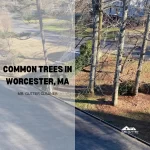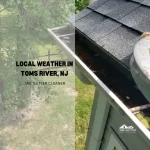In Pittsburgh, PA, homeowners face unique challenges in maintaining their gutters due to the variety of local trees. These trees, often shedding leaves and seed pods, are a major cause of gutter blockages.
Regular gutter cleaning is essential for preventing these blockages, which can lead to severe water damage and compromise the integrity of a home’s structure.
Understanding the types of trees common in Pittsburgh and their shedding patterns is crucial for homeowners.
This knowledge aids in planning maintenance schedules and adopting preventive measures to protect their property.
The importance of this task cannot be overstated, as neglected gutters can result in costly repairs.
By aligning gutter maintenance with the shedding cycles of local trees, homeowners can efficiently safeguard their homes against potential damage.
This proactive approach not only preserves the home’s condition but also enhances its longevity, ensuring a safe and comfortable living environment.
Introduction to Trees in Pittsburgh
Trees in Pittsburgh, PA, play a significant role in the city’s ecosystem and directly impact home maintenance, particularly gutter health. This section focuses on the most common tree species in Pittsburgh, their distinctive shedding characteristics, and the implications for gutter maintenance.
Why Are Pittsburgh’s Trees Unique?
Pittsburgh’s urban forest comprises diverse species, each with unique shedding patterns. Maple, Oak, and Elm trees are prevalent, known for their heavy leaf fall. These species, especially during autumn, shed leaves and seed pods that can clog gutters. Identifying these trees helps homeowners anticipate and manage gutter cleaning needs.
Common Tree Species in Pittsburgh and Their Characteristics
- Maple Trees: Predominant in Pittsburgh, they shed large quantities of leaves in the fall.
- Oak Trees: Known for their acorns and leaves, contributing to gutter blockage.
- Elm Trees: Shed small leaves but in large volumes, necessitating frequent gutter cleaning.
Understanding these tree species and their shedding behaviors enables homeowners to better plan gutter maintenance schedules, preventing potential damage caused by clogged gutters. Regular cleaning and timely intervention are crucial to maintaining the structural integrity of homes in Pittsburgh, where these tree species are common
Impact of Trees on Home Maintenance
The presence of trees, particularly in Pittsburgh, PA, greatly influences home maintenance routines, especially concerning gutter cleaning. This section explores how different tree species affect gutter health and the challenges they present during various seasons.
How Trees Affect Gutter Health
Trees, with their seasonal shedding of leaves and seed pods, pose a constant challenge to gutter systems. In Pittsburgh, the accumulation of organic debris from local trees like Maples, Oaks, and Elms can lead to clogged gutters. This blockage, if not addressed, can cause water damage, foundation issues, and attract pests. Regular cleaning and maintenance of gutters are vital to prevent these problems. Homeowners need to be particularly vigilant during the fall and early spring when shedding is at its peak.
Seasonal Challenges with Different Tree Species
- Fall: The most critical time for gutter maintenance, as trees like Maples and Oaks shed their leaves profusely.
- Spring: Trees such as Elms release seed pods, which can accumulate quickly in gutters.
- Year-Round: Pine trees, common in some Pittsburgh areas, drop needles throughout the year, necessitating regular gutter checks.
Understanding the specific challenges posed by local tree species in Pittsburgh is essential for homeowners to develop effective gutter maintenance strategies. This knowledge helps in scheduling cleanings at optimal times, thereby reducing the risk of gutter-related issues and ensuring the longevity and health of their homes.
Understanding Gutter Clogging
Gutter clogging is a critical issue for homeowners in Pittsburgh, PA, largely influenced by the shedding of leaves and seed pods from common local trees. This section delves into the causes of gutter clogs and the specific trees that contribute to this problem.
What Causes Gutters to Clog?
Gutters clog primarily due to the accumulation of leaves, twigs, and seed pods. In Pittsburgh, where Maple, Oak, and Elm trees are prevalent, gutters are particularly susceptible to blockages. These trees shed significant amounts of foliage and debris, especially during the fall and spring. When this debris accumulates, it obstructs the flow of water, leading to clogged gutters. This blockage can cause water to overflow, potentially damaging the home’s foundation, siding, and landscaping. Regular cleaning and maintenance are essential to prevent these issues.
Identifying Trees That Shed Leaves and Seed Pods
- Maple Trees: Notorious for their dense leaf fall, they significantly contribute to gutter clogs.
- Oak Trees: Besides leaves, they shed acorns, which can obstruct gutter flow.
- Elm Trees: Their small leaves and seed pods can easily accumulate and create blockages.
Homeowners in Pittsburgh need to be aware of these specific tree species and their shedding patterns. By understanding which trees are most likely to cause gutter clogs, homeowners can take proactive steps in scheduling gutter cleaning and maintenance, thereby protecting their homes.
Regular Gutter Cleaning: A Necessity
Regular gutter cleaning is not just a maintenance task but a crucial preventative measure for homeowners in Pittsburgh, PA. This section emphasizes the necessity of consistent gutter cleaning in the context of the local tree species and their impact on gutters.
The Role of Trees in Gutter Blockage
Trees, particularly Maples, Oaks, and Elms, commonly found in Pittsburgh, significantly contribute to gutter blockage. Their leaves and seed pods, especially during fall and spring, accumulate rapidly in gutters. This accumulation, if unchecked, leads to clogs that can cause water overflow and damage to the home’s foundation and exterior. Regular gutter cleaning, therefore, is essential in preventing these blockages and maintaining the integrity of the home.
Seasonal Gutter Maintenance Tips
- Fall: Prioritize gutter cleaning to remove leaves and debris from summer and fall shedding.
- Spring: Inspect and clean gutters to clear seed pods and remnants from winter storms.
- Routine Checks: Perform regular inspections, especially after heavy winds or storms.
Regular gutter maintenance is a key aspect of home care in Pittsburgh. By understanding the shedding patterns of local trees and aligning maintenance activities accordingly, homeowners can effectively mitigate the risk of gutter blockages. This proactive approach ensures the longevity and safety of their homes, preventing costly repairs and maintaining the home’s aesthetic appeal.
Choosing the Right Trees for Your Yard
Selecting the right trees for your yard in Pittsburgh, PA, can significantly reduce the frequency of gutter cleaning and maintenance. This section provides guidance on choosing tree species that minimize gutter clogging, balancing aesthetics, and practicality.
Trees with Minimal Impact on Gutters
Certain trees are less likely to clog gutters due to their minimal shedding or the nature of their leaves and seeds. Examples include:
- Flowering Dogwood: Sheds small amounts of foliage.
- American Holly: Produces minimal leaf and berry debris.
- Eastern Redbud: Low shedding tree, ideal for Pittsburgh climates.
By choosing these or similar trees, homeowners can enjoy the benefits of a green environment while minimizing gutter cleaning chores. It’s important to consider the growth pattern, root system, and overall size of these trees to ensure they fit well in the yard without affecting the house’s structure.
Balancing Aesthetics and Maintenance in Tree Selection
While selecting trees, homeowners should consider both the visual appeal and maintenance requirements. Deciduous trees, though beautiful in fall, may lead to more gutter cleaning. Evergreens, while less troublesome for gutters, may not provide the desired fall colors. A mix of both can create a visually appealing landscape while distributing the gutter maintenance workload throughout the year.
DIY vs. Professional Gutter Cleaning
For homeowners in Pittsburgh, PA, deciding between DIY and professional gutter cleaning is crucial, especially considering the challenges posed by local tree species. This section explores the scenarios where each option is suitable and the benefits of professional services.
When to Clean Your Gutters Yourself
DIY gutter cleaning is feasible for homeowners who have the necessary tools, safety equipment, and confidence to work at heights. It’s appropriate for smaller homes or when the gutter system is not heavily clogged. However, DIY should only be attempted when safety can be assured. Basic cleaning after mild shedding from trees like the Eastern Redbud or American Holly can often be managed without professional help.
The Benefits of Professional Gutter Cleaning Services
- Safety: Professionals have the right equipment and expertise to safely clean gutters, especially in homes with multiple stories or complex rooflines.
- Thoroughness: They can effectively clear heavy blockages caused by Maple and Oak trees, ensuring the gutter system functions optimally.
- Preventive Inspection: Professionals often identify and address potential issues like minor repairs, which might go unnoticed in DIY cleaning.
Deciding between DIY and professional gutter cleaning depends on the individual homeowner’s situation, the complexity of the task, and the type of trees around the property. Professional services offer thoroughness, safety, and peace of mind, particularly valuable in areas with trees prone to heavy shedding. Homeowners should weigh these factors carefully to make an informed decision that ensures their gutter system’s efficiency and longevity.
Long Term Solutions and Preventive Measures
For homeowners in Pittsburgh, PA, dealing with gutter blockages due to tree debris, long-term solutions and preventive measures are crucial. This section discusses effective strategies to minimize gutter cleaning and maintenance efforts in the long run.
Gutter Guards and Their Effectiveness
Gutter guards are a viable long-term solution to reduce the frequency of gutter cleaning. These devices act as a barrier, preventing leaves and seed pods from entering the gutters while allowing water to flow through. There are various types, including mesh screens and foam guards, each suitable for different kinds of debris. While not eliminating the need for cleaning entirely, gutter guards significantly lessen the workload and protect against severe clogs caused by the leaves of Maple, Oak, and Elm trees prevalent in Pittsburgh.
Landscaping Tips to Minimize Gutter Cleaning
- Strategic Planting: Position trees away from the home to reduce the amount of debris falling into gutters.
- Regular Pruning: Keep trees well-pruned to minimize the volume of leaves and twigs shed.
- Choosing Low-Shedding Trees: Opt for trees with minimal shedding characteristics, like the Eastern Redbud, to reduce gutter blockage.
Implementing these long-term solutions and preventive measures can greatly diminish the impact of tree debris on gutter systems. Gutter guards offer a practical way to keep gutters clear, while thoughtful landscaping can mitigate the amount of debris produced. These strategies, when applied effectively, can save homeowners in Pittsburgh time and money, ensuring their gutter systems remain functional and their homes protected.
Conclusion
The conclusion of this document reinforces the importance of regular gutter cleaning in Pittsburgh, PA, particularly in the context of the challenges posed by common local tree species. This final section reiterates the key points covered and emphasizes the necessity of proactive gutter maintenance for homeowners.
The Importance of Being Informed About Local Trees
Understanding the types of trees in Pittsburgh, such as Maples, Oaks, and Elms, and their impact on gutter health is crucial. Homeowners equipped with this knowledge can better plan and execute gutter maintenance, aligning cleaning schedules with the shedding patterns of these trees. Being informed helps in preventing severe gutter blockages and the resultant damage to property.
Maintaining Your Home in Harmony with Nature
In conclusion, maintaining gutters in a city rich with diverse tree species requires a balanced approach. While enjoying the aesthetic and environmental benefits of these trees, homeowners must also take responsibility for regular gutter maintenance. Proactive measures, like installing gutter guards, choosing low-shedding trees, and employing professional cleaning services when necessary, can significantly ease the burden of gutter maintenance. Ultimately, understanding and adapting to the natural environment of Pittsburgh enables homeowners to protect their homes while coexisting harmoniously with nature.


